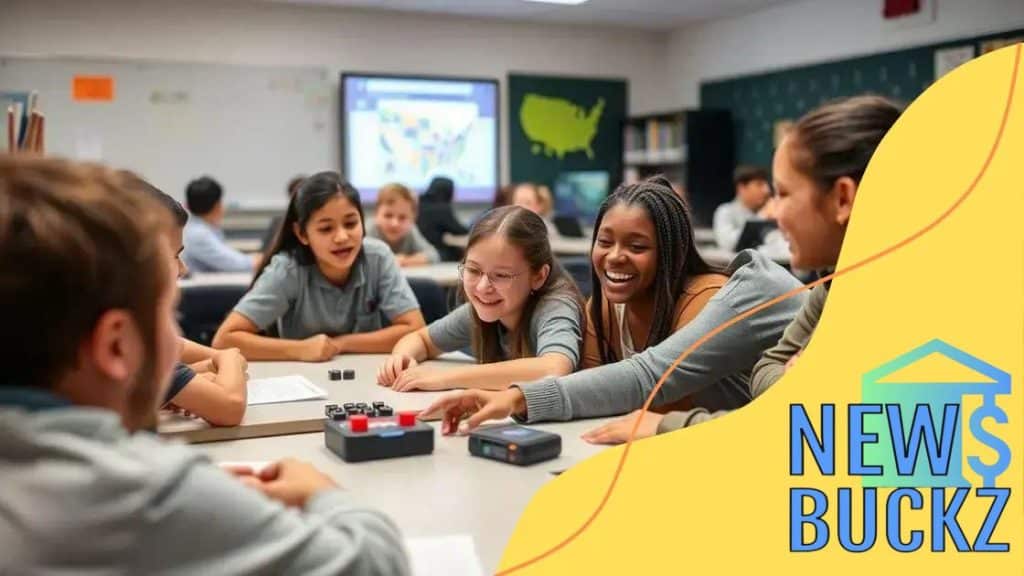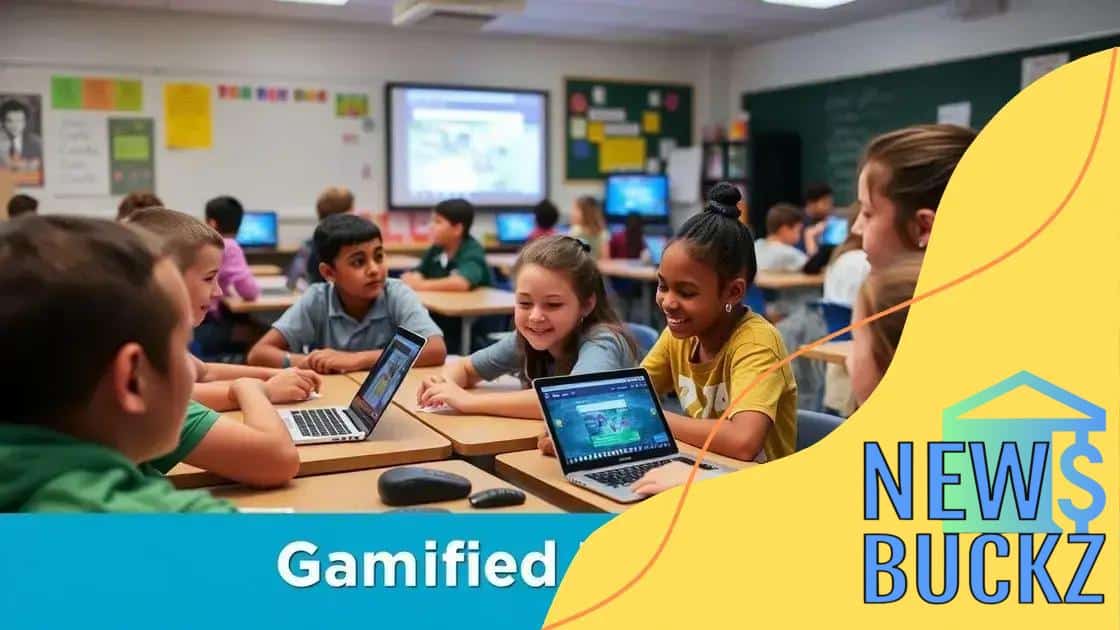How schools are using gamification to improve student outcomes

Anúncios
Schools are using gamification to improve student outcomes by incorporating game elements into lessons, enhancing engagement, motivation, collaboration, and critical thinking while utilizing technology like AR and VR for immersive learning experiences.
How schools are using gamification to improve student outcomes is reshaping the learning environment. Imagine classrooms buzzing with activity, where students are actively engaged in their lessons, all thanks to gamification techniques. How can this impact your child’s education?
Anúncios
Understanding gamification in education
Understanding gamification in education is essential for grasping how this innovative approach reshapes classrooms. It’s not just about games, but about applying game elements to enhance learning. This method makes schoolwork feel more like play, encouraging active participation.
One key aspect of gamification is its ability to motivate students. When lessons incorporate elements like rewards and challenges, students engage more deeply. They begin to see learning as an adventure.
What are the main components of gamification?
Gamification relies on several core elements to function:
Anúncios
- Points: Students earn points for completing tasks, motivating them to participate.
- Badges: Achieving certain milestones grants badges that signify accomplishment.
- Leaderboards: Comparing performance with peers can inspire competition and collaboration.
- Challenges: Engaging tasks that push students to stretch their abilities.
These components work together to create a stimulating environment. Incorporating gamification into lessons can lead to improved student outcomes.
Additionally, gamification can adapt to various subjects. Whether in math, science, or language arts, students can benefit from interactive experiences that promote a love for learning. This strategy can bridge gaps in understanding by offering multiple ways to engage with content.
Teachers are also adapting their methods to fit these new trends. They create scenarios where students can role-play or solve real-world problems, encouraging critical thinking and teamwork. As a direct result, learning becomes an engaging experience.
Why is gamification effective?
One reason gamification works so effectively in education is that it taps into intrinsic motivation. When students find enjoyment in their work, they are more likely to absorb and retain information. It also helps them develop soft skills like collaboration and resilience.
Moreover, as schools continue to embrace technology, gamified learning can seamlessly integrate with digital platforms. This combination enhances traditional teaching methods, providing diverse tools and strategies for educators.
With the rise of gamification, the future of education looks promising. Understanding this trend is crucial for educators, students, and parents alike. It opens doors to innovative learning experiences, making school more enjoyable and effective.
Benefits of gamification for students
Benefits of gamification for students are numerous and can significantly enhance the learning experience. By incorporating game elements into education, students become more engaged and motivated. This approach leads to better retention of information and encourages a positive attitude towards learning.
One major advantage of gamification is its ability to tailor learning experiences to individual needs. As students progress through challenges, they can learn at their own pace, gaining confidence along the way.
How does gamification benefit students?
Here are some key benefits:
- Increased engagement: Students are more likely to participate actively when lessons include game-like elements.
- Enhanced motivation: Rewards and challenges inspire students to strive for excellence.
- Improved collaboration: Many gamified learning experiences promote teamwork, allowing students to work together towards common goals.
- Better feedback: Immediate feedback on performance helps students to identify areas for improvement.
Moreover, gamification can make complex subjects more approachable. When topics become interactive, students often find them less daunting. They can visualize concepts and apply them in a fun, low-pressure environment.
This method also encourages creativity and problem-solving. As students navigate through various scenarios, they develop critical thinking skills. They learn to take risks in a safe setting, preparing them for real-world challenges.
Real-life examples of gamification impact
Many schools have seen astounding results from gamifying their lessons. Teachers report higher attendance and enthusiasm. Students often take pride in their achievements, leading to a greater sense of personal ownership of their education.
Additionally, gamification fosters a sense of community. Students can celebrate each other’s successes and support each other in reaching goals. This camaraderie makes the classroom a more enjoyable place to be.
Overall, the benefits of gamification extend beyond just academic performance. They help create well-rounded individuals who are prepared for the future. Gamification is reshaping how students engage with learning, and its positive effects are clear.
Successful case studies of gamified learning

Successful case studies of gamified learning showcase how this approach can transform the educational landscape. Schools around the world have adopted gamification strategies, leading to impressive results. These real-life examples highlight the power of incorporating game elements into lessons.
In one prominent case, a middle school in California implemented a gamified math program. Here, students earned points for completing assignments and participating in class. This method significantly increased engagement, with students reporting higher interest in math. Educators noticed improved test scores as well.
Examples of gamified success
Another notable example comes from a high school in Australia. They integrated gamification into their science curriculum, introducing badges for various achievements. Students were motivated to explore topics further to unlock new badges. As a result, they not only grasped complex concepts but also collaborated more effectively in groups.
- Game-based learning platforms: Schools are using platforms like Khan Academy and Classcraft to encourage students.
- Story-driven lessons: Courses were designed around narratives, allowing students to feel like heroes in their educational journey.
- Team challenges: Classes frequently engaged in friendly competitions, making learning engaging and fun.
These strategies foster a sense of community among students. Collaboration and competition push peers to motivate each other, creating a supportive learning environment. Students who may have struggled in traditional settings found themselves thriving when engaged in gamified experiences.
Furthermore, the use of technology in these case studies is significant. Schools employed various digital tools, creating personalized learning experiences. With the integration of interactive platforms, teachers could easily track progress and adapt lesson plans accordingly. This flexibility also means that students can learn at their own pace, leading to a deeper understanding of the material.
Ultimately, successful case studies of gamified learning reveal the effectiveness of this educational approach. They shine a light on how innovative techniques can inspire students, enhance understanding, and foster a love for learning.
Tech tools that facilitate gamification
Tech tools that facilitate gamification play a crucial role in modern education. These innovative resources enhance the learning experience and make it more interactive. Schools can choose from a range of tools that are designed to engage students and incorporate game-like elements into lessons.
One popular tool is Kahoot! This platform allows teachers to create fun quizzes that students can participate in using their devices. Students earn points for correct answers and can see real-time rankings, making learning more competitive and enjoyable.
Examples of effective gamification tools
Another fantastic option is Classcraft, a role-playing game that transforms the classroom into an interactive adventure. Students create avatars and work together to complete quests, earning rewards for positive behavior and collaboration. This not only motivates students but also improves social skills.
- Quizizz: Similar to Kahoot!, it allows students to take quizzes at their own pace, which increases accessibility.
- Edmodo: A platform that offers various features like badges and rewards for submissions, helping to foster a sense of achievement.
- Seesaw: This tool promotes student engagement through digital portfolios, allowing them to showcase their learning and collect badges for accomplishments.
These tech tools create a dynamic atmosphere in the classroom. By integrating technology, teachers can track student progress easily and identify areas where additional support may be needed. This feedback loop is essential for enhancing student learning.
Additionally, using gamification strategies allows students to work in collaborative settings. They build teamwork skills while enjoying the learning process. Engaging with their peers in meaningful ways helps them to create lasting memories associated with learning.
As technology evolves, the tools available for gamifying education continue to develop and improve. Educators can adapt their teaching methods and strategies, ensuring that lessons remain fresh and relevant. The power of technology in the classroom not only supports students but also inspires teachers to think creatively.
Future trends in educational gamification
Future trends in educational gamification are shaping how teachers interact with students and help them learn. As technology advances, gamification continues to evolve, making it a powerful tool in modern education. One key trend is the increasing use of virtual and augmented reality.
Virtual reality (VR) allows students to immerse themselves in different environments. This can enhance their understanding of complex subjects. For example, students can explore the solar system or walk through historical landmarks, all from their classrooms.
Emerging technologies driving gamification
Augmented reality (AR) is also gaining popularity in the classroom. It overlays digital information onto the real world, making lessons more interactive. Students can scan objects to reveal additional information or complete challenges that blend gameplay with real-life scenarios.
- Artificial intelligence: AI can personalize learning experiences, adapting to each student’s pace and style.
- Mobile learning: More students are using smartphones and tablets for educational games, making learning accessible anywhere.
- Hybrid learning environments: Blending online and in-person instruction maximizes engagement through gamified platforms.
Another trend is the emphasis on social learning through gamification. Educational game platforms encourage teamwork, allowing students to collaborate on quests and challenges. This fosters a sense of community among classmates, improving both academic performance and social skills.
Moreover, as data analytics becomes more integral to education, teachers can track student progress and engagement levels more effectively. This insight allows educators to refine their gamification strategies, ensuring that lessons meet the needs of all students.
Looking ahead, the integration of storytelling in gamified learning is expected to rise. Creating rich narratives around lessons helps captivate students and makes learning feel more relevant. Gamified elements will expand beyond simple rewards, incorporating deeper storytelling arcs that resonate with learners.
In conclusion, the future of educational gamification is bright. As technology continues to advance, educators will have even more tools at their disposal to inspire students. Gamification is transforming classrooms, bringing excitement and a fresh approach to learning.
The future of educational gamification is exciting and full of potential. As technology advances, we can expect more interactive tools and immersive experiences in classrooms. By adopting gamification techniques, teachers can create engaging lessons that captivate their students. This change will not only improve academic performance but also foster teamwork and critical thinking skills. The integration of technology, storytelling, and social learning will continue to enrich the educational landscape, ensuring that learning is both fun and effective.
FAQ – Frequently Asked Questions about Gamification in Education
What is gamification in education?
Gamification in education refers to the use of game elements in learning environments to increase engagement and motivation among students.
How can technology enhance gamification?
Technology, such as virtual reality (VR) and augmented reality (AR), can immerse students in interactive learning experiences, making lessons more engaging.
What are the benefits of gamification for students?
Gamification enhances student motivation, encourages collaboration, and helps improve critical thinking and problem-solving skills.
Can gamification be used in all subjects?
Yes, gamification can be applied across various subjects, allowing teachers to create interactive and enjoyable learning experiences in any discipline.





